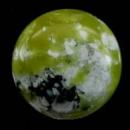|
|
||||||||||||||||
|
||||||||||||||||
|
||||||
|
|
|
|
Serpentine
(Serpentine
Group) |
|
| | |
| Serpentine first cited in 1564; IMA status: Not Valid (name of a Group of minerals) | ||
|
| ||
|
Chemistry |
|
|
| |
|
D3[Si2O5](OH)4
+/-
n(H2O);
(Serpentine Group) | |
|
|
Magnesium Silicate Hydroxide (Antigorite, Lizardite & Chysotile) |
|
Molecular Weight: |
277.11 gm (Lizardite) |
|
Composition (Lizardite): |
Magnesium |
26.31 % |
Mg |
43.63 % |
MgO |
|
|
Silicon |
20.27 % |
Si |
43.36 % |
SiO2 |
|
|
Hydrogen |
1.45 % |
H |
13.00 % |
H2O |
|
|
Oxygen |
51.96 % |
O |
|
|
|
|
|
100.00 % |
|
100.00 % |
= TOTAL OXIDE |
|
|
|
||||
|
Classification |
|
|
| |
|
Silicates (Germanates) | |
|
8/H.27-20 | |
|
|
9 : SILICATES (Germanates)
|
|
Related to: |
Serpentine Group (a subgroup of the Kaolinite-Serpentine Group). Closely related to Antigorite. |
|
Members of Group: |
Serpentine Group: Antigorite, Chrysotile, Clinochrysotile, Lizardite. Kaolinite-Serpentine Group: Amesite, Antigorite, Baumite, Berthierine, Brindleyite, Caryopilite, Chrysotile, Clinochrysotile, Cronstedtite, Dickite, Fraipontite, Greenalite, Halloysite, Kaolinite, Kellyite, Lizardite, Manandonite, Nacrite, Népouite, Odinite, Orthochrysotile, Parachrysotile, Pecoraite, Webskyite |
|
Varieties: |
Bastite, Marmolite, Ni-Serpentine, Nickeliferous Serpentine, Pelhamine, Radiotine, Retinalite, Ricolite, Serpentinasbest, Serpentine Jade |
|
Synonyms: |
Hydrophite, Kandite, Kaolinite Group, Piknotrop, Pycnotrope, Pyknotrop, Serpentine, Serpophite |
|
|
|
|
Crystal Data |
|
|
|
|
|
Triclinic - Pinacoidal (Lizardite) |
|
|
(Lizardite) Crystals rare, to 2 mm, as trigonal plates to truncated trigonal pyramids. Commonly as extremely fine-grained scales and massive aggregates. |
|
|
None |
|
|
|
|
|
Physical Properties |
|
|
|
|
|
Perfect on {0001} |
|
|
n/a |
|
|
Crystals are easily bent. |
|
|
2.5 |
|
|
2.55 (g/cm3) |
|
|
None |
|
|
Not Radioactive |
|
|
|
|
|
Optical Properties |
|
|
|
|
|
Green, light yellow to white; colorless to pale green in thin section |
|
|
Translucent |
|
|
Waxy |
|
|
1.538 - 1.568 Uniaxial (-) to slightly Biaxial (-) |
|
|
0.012 |
|
|
Weak to distinct |
|
|
n/a |
|
|
|
|
|
Occurances |
|
|
|
|
|
Geological Setting: |
Typically a product of retrograde metamorphism, replacing Olivine, Orthopyroxene, or other minerals in ultramafic igneous rocks. |
|
Common Associations: |
Chrysotile, Brucite, Magnetite |
|
Common Impurities: |
n/a |
|
Type Locality: |
Eastern Cliff, Kennack Cove (Kennack Sands), Kennack, Grade-Ruan, Lizard Peninsula, Cornwall, England, UK (Lizardite) |
|
Year Discovered: |
1956 (Lizardite) |
|
View mineral photos: | |
|
|
|
|
More Information |
|
|
|
|
|
|
Mindat.org
(Serpentine Group) |
|
|
|
|
Serpentine was named in 1564 by Georgius Agrigola (1494-1555) from the Latin word serpens meaning snake in allusion to the mottled green appearance of the mineral suggesting the resemblance to some snakes. Georgius Agrigola was a German Catholic scholar and scientist known as "the father of mineralogy". His birth name was Georg Pawer (Bauer in modern German). Agricola is the Latinized version of his name, by which he was known his entire adult life. Agricola and Bauer mean "farmer" in their respective languages. He is best known for his book De Re Metallica (Latin for On the Nature of Metals (Minerals)). It is a book cataloguing the state of the art of mining, refining, and smelting metals at the time. It was published in 1556, a year after his death, due to a delay in preparing woodcuts for the text. The book was the authoritative text on mining for 180 years after its publication. It was also an important chemistry text for the period and is significant in the history of chemistry. Distribution:
Probably the most common serpentine mineral. A few prominent
localities for well-studied material include: at Kennack
Cove, The Lizard, Cornwall, England. On Unst, Shetland
Islands, Scotland. From near Val Sissone, Lombardy,
and Val Trebbia, Piacenza, Italy. In Japan, from Maruo
Odori and Kodo, Yamaguchi Prefecture, and at Hamao,
Fukuoka Prefecture. At Woodsreef, New South Wales, Australia.
From the Jeffrey mine, Asbestos, Quebec, and the Cassiar
mine, British Columbia, Canada. In the USA, in the Stillwater
complex, Montana. |
|
|
We
have not photographed our Serpentine
gems yet. Please
check back soon. |
